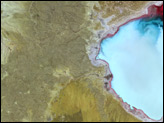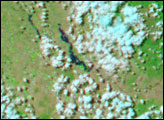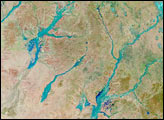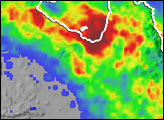

Australia’s recent floods have breathed life into the normally dry, seasonal wetlands in the continent’s interior. Lake Yamma Yamma, shown above, is a shallow depression just west of the Cooper Creek floodplain in southwestern Queensland. The lake is usually a dry desert bowl, a playa lake, that collects water only when Cooper Creek floods. This year, Yamma Yamma has become an inland sea measuring 20 kilometers (12 miles) across. These images, taken by the Advanced Spaceborne Thermal Emission and Reflection Radiometer (ASTER) on the Terra satellite, contrast this year’s shorelines with the lake’s extent in 2001. Old shorelines show that the basin is not as full as it has been in the past, but Lake Yamma Yamma is clearly fuller this year than in 2001. Though the lake is shallow, it covers a large area and can hold a large volume of water.
The influx of water into Lake Yamma Yamma and other interior lakes brings fish and a variety of birds to the outback. Pelicans, swans, ducks, and other bird species flock to the new water sources in the desert. Another sign of new life is the ring of red along the shore where new vegetation is growing. In this false-color infrared image, green plants appear red. Other lakes in Australia’s interior have also benefited from the floods. At the end of the Cooper Creek flood basin, Lake Eyre, Australia’s largest lake, has begun to fill for the first time in four years.
The high-resolution images provided above are at ASTER’s full resolution of 15 meters per pixel.
Image courtesy Jesse Allen based on data from the U.S./Japan ASTER Science Team
The northern monsoon brought heavy rains and floods to Eastern Australia.



